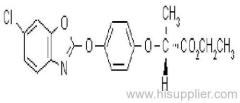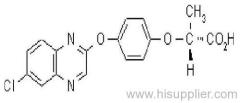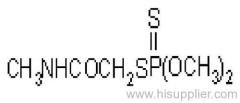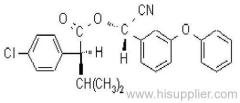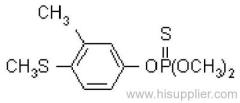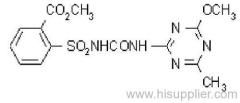
|
Shanghai Skyblue Chemical Co., Ltd.
|
Metiram
| Place of Origin: | Shanghai, China (Mainland) |
|
|
|
| Add to My Favorites | |
| HiSupplier Escrow |
Product Detail
Non-systemic foliar fungicide with protective action.
Common name: metiram; métirame zinc
IUPAC name: zinc ammoniate ethylenebis(dithiocarbamate) - poly(ethylenethiuram disulfide)
Chemical Abstracts name: metiram (composition not specified)
CAS RN: [9006-42-2]
IUPAC name: zinc ammoniate ethylenebis(dithiocarbamate) - poly(ethylenethiuram disulfide)
Chemical Abstracts name: metiram (composition not specified)
CAS RN: [9006-42-2]
PHYSICAL CHEMISTRY
Composition: No common name was accepted by ISO (and metiram was withdrawn by BSI), because the product appears to be a mixture rather than a complex. The dry form of the tech. is 'Metiram TC 85%'. Mol. wt.: (1088.7)x M.f.: [C16H33N11S16Zn3]x Form: Yellow powder (tech.) M.p.: Decomposes at c. 156 ºC. V.p.: <0.010 mPa (20 ºC). KOW: logP = 0.3 (pH 7) Henry: <5.4x10-3 Pa m3 mol-1 (calc.) S.g./density: 1.860 (20 °C) Solubility: Practically insoluble in water. Soluble in pyridine (with decomposition). Practically insoluble in organic solvents (e.g. ethanol, acetone, benzene). Stability: Stable at 30 ºC. Slowly decomposed by light. Non-hygroscopic. Decomposed by strong acids and strong alkalis.
APPLICATIONS
Biochemistry: Non-specific thiol reactant, inhibiting respiration.
Mode of action: Non-systemic foliar fungicide with protective action.
Uses: Control of a wide range of diseases on many crops, e.g. scab on pome fruit; shot-hole on stone fruit; rust on currants and plums; downy mildew, red fire disease, and black rot on vines; Phytophthora late blight on potatoes and tomatoes; Septoria leaf spot on celery and celeriac; downy mildew on head lettuce; rust on asparagus; anthracnose on beans; downy mildews on hops and tobacco; downy mildews and rusts on ornamentals; diseases of cotton, peanuts, pecans, etc. Application rates in the range 1.5-4.0 kg/ha. Used in forestry to combat needle cast in conifers. Also used as a seed treatment for control of emergence diseases of vegetables and ornamentals.
Formulation types: WP,WG.
Compatibility: Incompatible with highly alkaline materials.
MAMMALIAN TOXICOLOGY
Oral: Acute oral LD50 for rats >10 000, mice >5400, guinea pigs 2400-4800 mg/kg.
Skin and eye: Acute percutaneous LD50 for rats >2000 mg/kg. Mild skin and eye irritant.
Inhalation: LC50 (4 h) for rats >5.7 mg/l air.
NOEL: (2 y) for rats 3.1 mg/kg.
ADI: 0.03 mg/kg b.w. (group ADI with mancozeb, maneb and zineb)
Toxicity class: WHO (a.i.) III (Table 5); EPA (formulation) IV
ECOTOXICOLOGY
Birds: Slightly toxic to birds.
Fish: LC50 (96 h) for carp 85, rainbow trout 1.1 mg/l. LC50 (48 h) for harlequin fish 17 mg/l.
Daphnia: EC50 (48 h) 2.55 mg/l.
Algae: EC50 (96 h) for Chlorella 0.3 mg/l.
Bees: LD50 (oral) >40 ug/bee; (contact) >16 ug/bee.
Worms: LC50 (14 d) >1000 ppm.
ENVIRONMENTAL FATE
Soil/Environment: As with other dithiocarbamate pesticides, metiram is degraded to derivatives of thiourea, thiuram monosulfide, thiuram disulfide, and sulfur.




